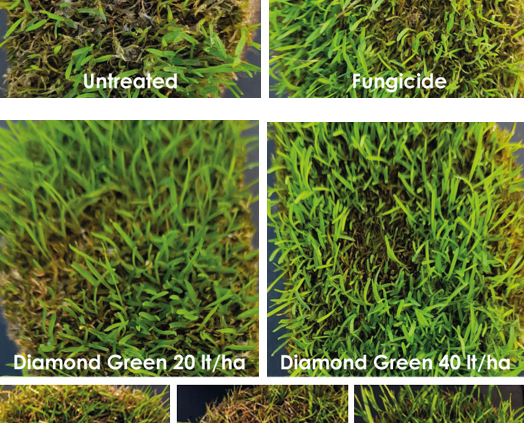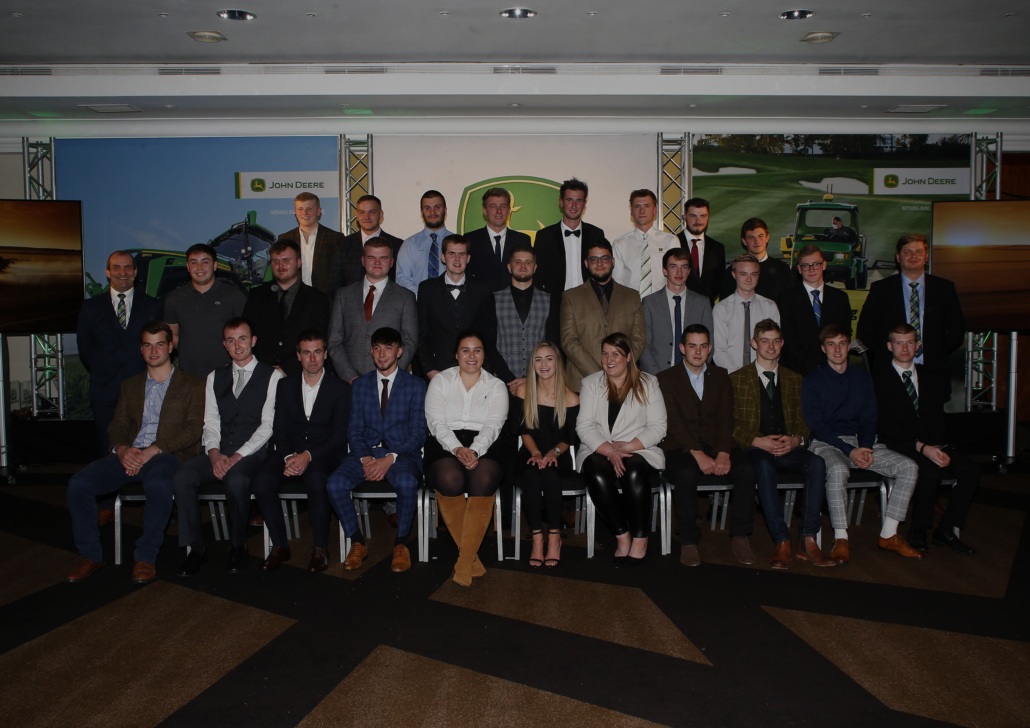Diamond Green – Continuation of Product Trials
Diamond Green – Continuation of Product Trials: Indigrow developed Diamond Green as a liquid fertiliser based on potassium, calcium and magnesium. It contains essential plant oils to enhance plant health and increase disease resistance in turf grass. The combination of nutrients in Diamond Green improves the plants natural resistance to many known pathogens.
After the successful development the additive formulation, trials of Diamond Green at different application rates were carried out to assess its impact on the spread of Fusarium and Red Thread. It was tested three different application rates to assess it’s effectiveness.

Diamond Green – Continuation of Product Trials
Diseased turf cores were harvested from infected areas of turf on a parkland golf course. The cores were harvested in late Summer 2021 when these diseases were very active. Disease levels were consistent across each core at the time of harvest.
Throughout the trials, our aim was to find our the effectiveness Diamond Green had of different turf grass diseases without killing the fungus. As Diamond Green is a fertiliser with additives, it was important for us to show how this formulation would prevent the spread of the fungus within the cores taken from the parkland golf course.
Treatments
The following treatments were tested for their potential to reduce disease spread in already infected turf stands:
Number Treatment Rate
1 Water: Untreated
2 Fungicide (Tebuconazole 200 g/lt + Trifloxystrobin 100 g/lt): 1 lt/ha
3 Diamond Green: 10 lt/ha
4 Diamond Green: 20 lt/ha
5 Diamond Green: 40 lt/ha
Methods
The turf cores were harvested for each treatment, one infected with Fusarium Patch and one infected with Red Thread. The cores were then sprayed with each treatment until the turf surface was fully covered. The treated turf was then sealed in clear boxes to provide the humidity conducive to active disease spread. The development of the disease and the health of the turf was then monitored over the next 4-5 days.
Fusarium – Observations 4 Days After Treatment
Over a period of 4 days, the active Fusarium had spread freely on the untreated turf core and white, active mycelium was observed. The fungicide treatment has suppressed the spread of Fusarium, but there is still a small amount of active mycelium present.
Number Treatment Estimated Disease
Spread (%)
1 Water: 47%
2 Fungicide (Tebuconazole 200 g/lt + Trifloxystrobin 100 g/lt): 14%
3 Diamond Green: 19%
4 Diamond Green: 8%
5 Diamond Green: 3%
At 10 lt/ha, Diamond Green has supressed the spread of Fusarium, but like the fungicide there is still a small amount of active mycelium present.
At both 20 and 40 lt/ha, Diamond Green has not only supressed the spread of Fusarium but allowed the turf to start to fill in disease scarred areas of turf. There is only a very small amount of active mycelium present on the turf
Red Thread – Observations 5 Days after Treatment
Over a period of 5 days, the active Red Thread has spread freely on the untreated turf core and active red areas can be observed.
At only 10 lt/ha, Diamond Green has had a limited impact on disease spread. However, at 20 lt/ha, the Red Thread has been almost completely suppressed and the turf has had a noticeable green up response and there is an obvious increase in growth rate.
Effect on Disease
It is important to state that Diamond Green is not a fungicide, it is a fertiliser with additives. We trialled both the fertiliser formulation without additives alongside the full Diamond Green formulation with additives. We found that when treated in isolation, the fungal growth is the same for just the fertiliser component as it is for the finished formulation containing the additives.
This confirms that it is the systemic acquired resistance within the plant that stops the spread of the disease.
Figure 1 – Diamond Green – Fertiliser component only
Figure 2 – Diamond Green Final Formulation Fertiliser component + additives

Diamond Green – Continuation of Product Trials
Other Diseases
As Diamond Green acts as a trigger to the plants natural defences, rather than having a direct effect on the fungus itself, it is safe to assume that the activity shown here on Fusarium and Red Thread would be similar on other turf grass diseases including: Anthracnose, Dollar Spot, Snow Moulds and Leaf Spot.
Conclusions
The applications of Diamond Green have been successful in reducing the spread of Red Thread and Fusarium and the higher the application rate of Diamond Green, the stronger the effect is on disease.
At higher application rates of Diamond Green, the treatment also produces a strong growth response, with turf able to quickly ‘fill in’ previously diseased/scarred areas. Although this trial was only observational, we have a strong indication that Diamond Green can play a vital role as part of an integrated disease management strategy. With the benefits to turf health (shown by increased growth response and improved colour), we predict that turf treated with Diamond Green will have improved resistance to future disease attack.
For the latest industry news visit turfmatters.co.uk/news
Get all of the big headlines, pictures, opinions and videos on stories that matter to you.
Follow us on Twitter and Instagram for fun, fresh and engaging content.
You can also find us on Facebook for more of your must-see news, features, videos and pictures from Turf Matters.

















